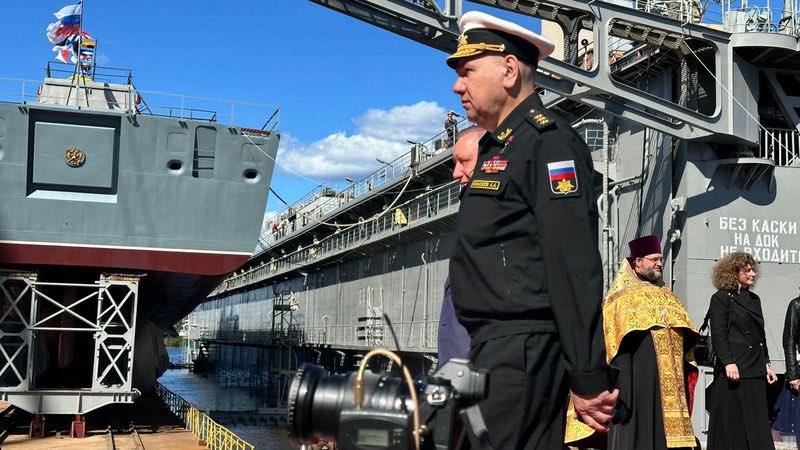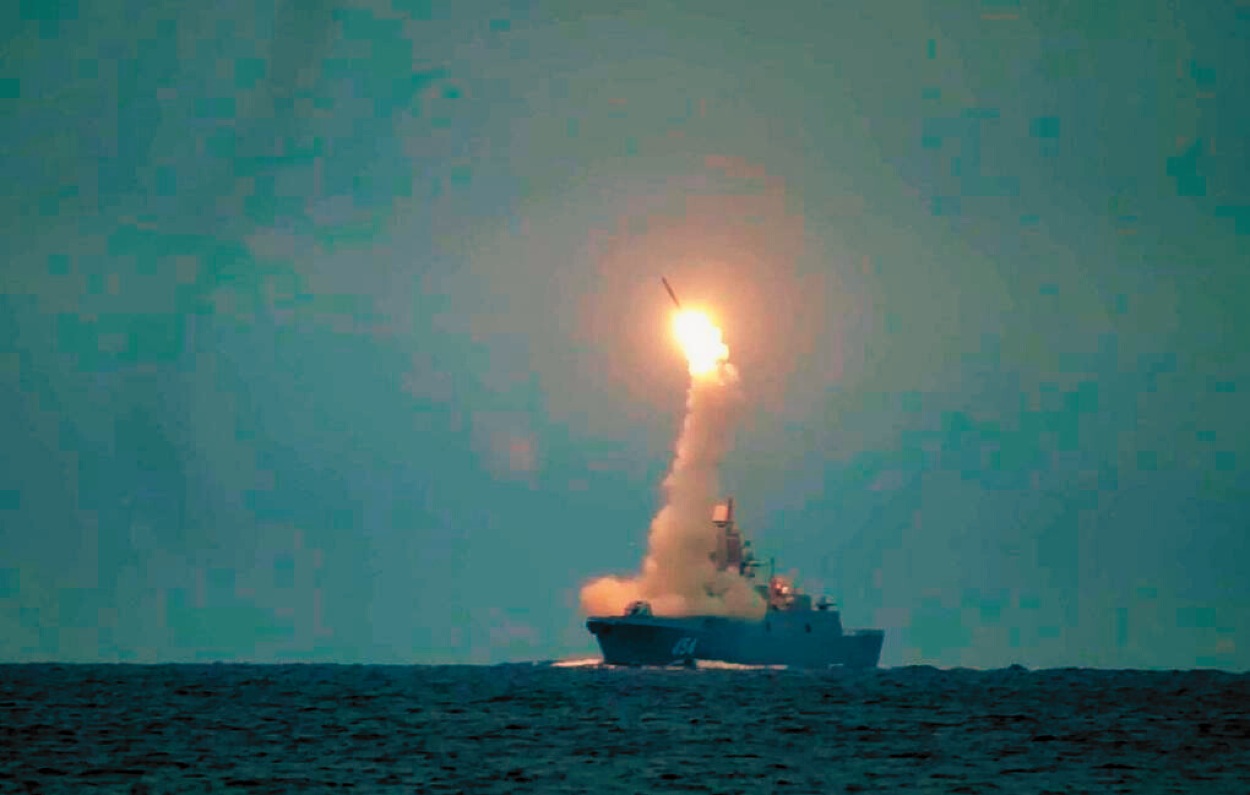Boasting the capabilities of the newly-launched Project 22350 Admiral Amelko, a popular Russian military expert said the vessel is a “sea terminator” and a kind of “universal soldier” that can attack nuclear-powered submarines and adversary aircraft carriers, in what appears to be an oblique reference to the US Navy.
The project 22350 ship Admiral Amelko—also referred to as the Gorshkov-class after the first ship—was launched at the Severnaya (Northern) Shipyard in St. Petersburg on August 14.
At the time, Russian Navy Commander-in-Chief, Admiral Alexander Moiseyev, said at the launch ceremony, “The frigate features all combat capabilities and is capable of accomplishing a whole range of objectives typical of a multi-purpose ship, both in the close-in and distant maritime zones.”
Admiral Amelko is one of the five Gorshkov ships, the only class of ocean-going combat vessels developed and produced in Russia after the collapse of the Soviet Union.
Three other vessels of the class—Admiral Gorshkov, Admiral Kasatonov, and Admiral Golovko are already in service. The keel of Admiral Amelko was laid in April 2019, and it is expected to be delivered to the Pacific Fleet by 2027. Three more frigates are currently under construction, including Admiral Chichagov, Admiral Yumashev, and Admiral Spiridonov.
These multipurpose missile frigates, which can conduct missions like long-range strikes and anti-submarine warfare (ASW), are designed to improve Russia’s blue-water capabilities.
This explains why the Russian expert, Alexander Stepanov of the Institute of Law and National Security within the Russian Presidential Academy of National Economy and Public Administration, called the vessel a “sea terminator.”
“Project 22350 frigates are the carriers of high-precision missile weapons – not only Kalibr [cruise] but also Tsirkon [hypersonic] missiles. The frigate is a sea terminator, a universal soldier that can hunt down enemy nuclear-powered submarines from a safe distance,” Alexander Stepanov was quoted as saying by the Russian state news agency TASS.
The expert explained that the Project 22350 frigate is a modular launcher platform that can handle the roles of identifying and eliminating priority targets in the coastal region, as well as components of carrier strike groups, such as aircraft carriers. Though he did not mention the United States, it is widely known that among Russian adversaries, America has the largest carrier fleet.
Russian military officials and experts have repeatedly noted that Project 22350 frigates are expected to become the Russian Navy’s most advanced warships in their class.
Alexander asserted that the battleship is equipped with 24 shipborne multipurpose launching systems, while emphasizing that the second-series Project 22350 frigates will get 32 launching system cells, while more advanced Project 22350M warships will carry at least 48 cells.
Additionally, the military expert stated that these cells are designed to accommodate Tsirkon hypersonic anti-ship missiles, which have an operational range of 400 to 1,500 kilometers and may penetrate a prospective enemy’s air defense and coastal anti-missile systems.
It is pertinent to note that Admiral Gorshkov, the first ship of the class, has test-fired the Tsirkon hypersonic missile in the past, as also reported by the EurAsian Times.

Alexander Stepanov further noted that Admiral Amelko’s launch can be seen as a response to the US Arleigh Burke-class destroyers’ ongoing deployments of precise weaponry, specifically Tomahawk multifunctional cruise missiles, in Pacific waters.
“We see that these systems are being placed on combat duty to guarantee the security of our waters. In coordination with the navies of our key allies, they will ensure consistent maritime patrols and safeguard marine navigation, including trade and economic routes, which the collective West is attempting to blockade,” he noted.
Notably, the comments come days after US President Donald Trump ordered two nuclear submarines to “be positioned in the appropriate regions” in response to “highly provocative” comments by former Russian President Dmitry Medvedev.
Moreover, the Arleigh Burke-class destroyers, as the backbone of the US Navy’s surface fleet, are frequently deployed in Pacific waters to maintain maritime security, conduct freedom of navigation operations, and counterbalance regional powers, including Russia and China.

Currently, the Russian Navy’s Pacific Fleet, based in Vladivostok, operates a mix of Soviet-era and modern vessels, with the Gorshkov-class frigates like Admiral Amelko being its most advanced surface combatants.
The induction of Admiral Amelko will likely enhance Russia’s naval capabilities in the Pacific, particularly with its hypersonic missile arsenal and multi-role functionality, posing a direct challenge to US naval assets and regional dominance, which has largely remained unchallenged by Russia in recent years.
Last year, Russian warships led by the frigate Admiral Gorshkov visited the Havana port in Cuba—a visit that was keenly watched by the United States. Additionally, the Admiral Gorshkov, along with the nuclear submarine ‘Kazan’ that also visited Cuba, conducted drills on the use of high-precision missile weapons in the Atlantic Ocean.
Moreover, it might also ruffle some feathers across Europe and as far as Japan, which has an active territorial dispute concerning the Kuril Islands with Moscow.
In addition to deterring Russian adversaries, this class of ships, including the Admiral Amelko, will also aid Moscow’s Blue Water Navy plans for the future.
Russia’s Sea Terminator Is Coming
Named after Admiral Nikolai Amelko, a distinguished Soviet naval commander, the vessel shares the core design of Project 22350 that has been developed to replace the outdated ships from the Soviet era, including the Krivak and Neustrashimy classes.
The Severnoye Design Bureau authorized the design in 2003, intending to build adaptable battleships that could function in oceanic zones and far-off waters.
According to reports, the project encountered obstacles, such as sanctions that required self-reliance in propulsion systems, which are currently driven by NPO Saturn’s domestic M55R combined diesel and gas turbine (CODAG) plant. This makes Admiral Amelko a more powerful platform than its predecessors.
Fifth in the class, it represents a significant advancement in Russia’s naval capabilities, particularly as the first vessel in its class to feature enhanced missile armament–24 vertical launch cells for the UKSK missile system.
This is significantly more than the 16 such cells carried by the previous ships in the class. The system can launch Zircon hypersonic missiles, Oniks supersonic missiles, and Kalibr cruise missiles, considered to be one of the best and most lethal in the world.

Russia is one of only a few countries in the world that have a ship-launched hypersonic missile.
For air defense, Admiral Amelko is equipped with 32 vertical launch system (VLS) cells dedicated to the Poliment-Redut system, an upgrade from earlier ships in the class, which enhances its capacity to engage aerial and ballistic threats.
The missiles include 9M96DM, which can engage targets at ranges up to 150 kilometres and altitudes up to 35 kilometres, and the 9M100, which has a range of 10–15 kilometres and high maneuverability to counter low-flying threats like cruise missiles.
The Poliment-Redut is designed to counter a wide range of threats, including fighter jets, helicopters, drones, cruise missiles, and ballistic missiles. It provides a layered defense for the frigate and nearby ships in a task force.
Moreover, the vessel is integrated with the Poliment 5P-27 active phased array radar, which provides 360-degree coverage and simultaneous tracking of multiple targets.
Stealth characteristics are incorporated into the frigate’s design to lower radar cross-section and make detection more difficult. It accommodates a hangar and helicopter deck for Ka-27, Ka-29, or Ka-31 helicopters, allowing for reconnaissance and ASW operations.
The frigate can effectively engage submarines, surface ships, aircraft, and land targets thanks to these capabilities. The survivability of the vessel is further improved by electronic warfare (EW) suites and countermeasures such as the 5P-42 Filin system.
The Admiral Amelko has a full displacement of 5,400 tons and a standard displacement of about 4,500 tons. The frigate has a speed of about 29 knots (53.7 kilometres per hour) and a range of 4,500 nautical miles or about 8,334 kilometres.
The ship can accommodate a crew of 170 people and is capable of about 30 days of autonomous operation, according to publicly available information.
- Contact the author at sakshi.tiwari9555 (at) gmail.com
- Follow EurAsian Times on Google News




